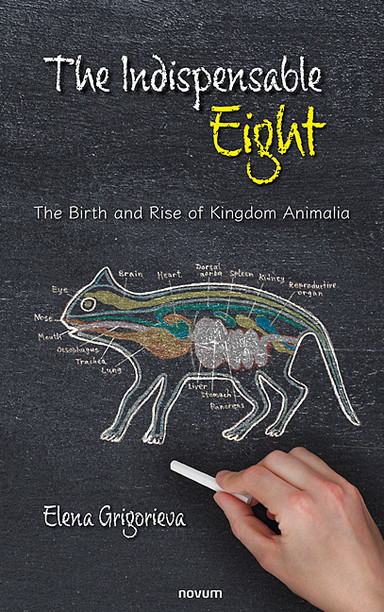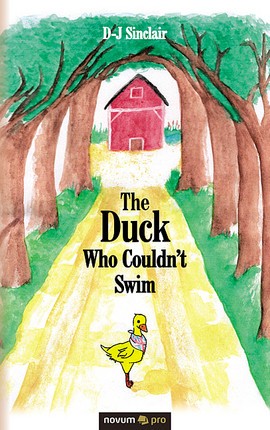The Indispensable Eight
The Birth and Rise of Kingdom Animalia
Elena Grigorieva
USD 25,99
USD 20,99
Format: 13.5 x 21.5 cm
Number of Pages: 46
ISBN: 978-3-99131-569-8
Release Date: 12.12.2022
A key question that scientists and laymen have long puzzled over is how did animals and humans evolve on Earth? Elena Grigorieva provides simple pictures and brief descriptions to understand how all these systems work and have progressed over aeons of time.
From Unicellular Protozoans to Multicellular Metazoans
Around 600 million years ago our planet Earth was very different from what it is now. There were no animals. Instead, there were various tiny, unicellular creatures which lived in the warm waters of the ancient oceans and lakes. Some of them had a long, tail-like structure – a flagellum, which they used for swimming. Biologists call these creatures protozoans.
In order to get nutrients essential for living, the protozoans ate other cells and organic structures. While feeding on bigger cells or food particles, the protozoans gathered into groups, or colonies. Eventually, some cells within such groups divided but remained connected to each other. This led to the formation of stable aggregates, where cells multiplied and grew as a single organism. Such multicellular organisms are called metazoans, and it is believed that the very first metazoans were the ancestors of all animals on Earth. They gave rise to the kingdom Animalia and marked the beginning of animal evolution.
How Cells Specialise
In the course of evolution, cells in some metazoans began to vary from each other in structure and function. This process is called cell specialisation and can be briefly described as follows.
Cells located on the outer side of metazoan organisms became more tightly connected to each other and were more resistant to the harmful effects of the environment, thereby protecting the inner-located cells. Over time, the outer cells gave rise to the epidermal cells, which form the outermost protective layer of the skin in complex animals.
Some cells became specifically sensitive to the environmental signals such as chemical substances, light, sound, or pressure. Moreover, they became able to transmit the signals to other cells of the organism, thereby giving rise to the first sensory and motor neurons.
Some cells became able to contract and relax in response to the signals from the neurons and, with the help of support cells, that allowed the metazoan to perform essential movements and keep a certain shape. Such kinds of cells gave rise to the first muscle and support cells.
Cells lining the inside cavity of the metazoan, and being in direct contact with food, specialised in digestion of organic particles by changing them into simple forms that could be easily used by all cells of the organism. These cells became the first digestive cells of the gut.
Metazoan cells need oxygen for energy production by a process of respiration, so some cells specialised in obtaining oxygen from the environment in larger quantities and in gas exchange, in order to fulfil the needs of the whole organism. These cells gave rise to the respiratory cells of the gills and lungs.
Some cells specialised in delivering oxygen and nutrients to every other cell of the organism, and also protected against harmful viruses, bacteria and other intruders. These cells became the first circulatory and immune cells.
Some cells specialised in sorting out the products of cellular metabolism and excreting unneeded molecules out of the organism. These cells gave rise to the excretory cells of the kidneys.
And finally, two kinds of haploid cells (containing only one set of chromosomes) – eggs and sperm cells – became responsible for giving birth to a new metazoan organism by means of sexual reproduction. These cells gave rise to the first reproductive cells.
How Animals Evolve
The division of cells to serve a specific function has played a key role in the evolution of metazoans and in the appearance of different animal species. Especially important has been the way by which metazoans reproduce, in particular, sexual reproduction. The genetic material of the nuclear DNA, which is carried into the egg cell by the sperm cell from the male organism, as well as molecular changes (or mutations) in the genomes of these cells, enable fast transmission of novel features and traits to new-born organisms. Sexual reproduction has led to an enormous varieties of animal species, which are characterised by different body structures, behaviours and habitats. After around 70 million years since the appearance of the first metazoans, Earth has become inhabited by animals as primitive as sponges and as complex as vertebrates.
It should be noted that the evolution of animals is a continuous process, which is influenced by many environmental conditions. Over the course of time, due to extreme changes in climate and other unfavourable factors, many animal species became extinct, while many others arose later, and many new species will appear in the future.
Biologists have described and classified over three million living animal species and 35 major body plans (or phyla), based on animals’ body structure and ways of development. Although profoundly different from each other, all animals share a common ancestor, the protozoan, and the eight types of cell specialisation have remained as the metazoan-specific features of the vast majority of animal species.
Around 600 million years ago our planet Earth was very different from what it is now. There were no animals. Instead, there were various tiny, unicellular creatures which lived in the warm waters of the ancient oceans and lakes. Some of them had a long, tail-like structure – a flagellum, which they used for swimming. Biologists call these creatures protozoans.
In order to get nutrients essential for living, the protozoans ate other cells and organic structures. While feeding on bigger cells or food particles, the protozoans gathered into groups, or colonies. Eventually, some cells within such groups divided but remained connected to each other. This led to the formation of stable aggregates, where cells multiplied and grew as a single organism. Such multicellular organisms are called metazoans, and it is believed that the very first metazoans were the ancestors of all animals on Earth. They gave rise to the kingdom Animalia and marked the beginning of animal evolution.
How Cells Specialise
In the course of evolution, cells in some metazoans began to vary from each other in structure and function. This process is called cell specialisation and can be briefly described as follows.
Cells located on the outer side of metazoan organisms became more tightly connected to each other and were more resistant to the harmful effects of the environment, thereby protecting the inner-located cells. Over time, the outer cells gave rise to the epidermal cells, which form the outermost protective layer of the skin in complex animals.
Some cells became specifically sensitive to the environmental signals such as chemical substances, light, sound, or pressure. Moreover, they became able to transmit the signals to other cells of the organism, thereby giving rise to the first sensory and motor neurons.
Some cells became able to contract and relax in response to the signals from the neurons and, with the help of support cells, that allowed the metazoan to perform essential movements and keep a certain shape. Such kinds of cells gave rise to the first muscle and support cells.
Cells lining the inside cavity of the metazoan, and being in direct contact with food, specialised in digestion of organic particles by changing them into simple forms that could be easily used by all cells of the organism. These cells became the first digestive cells of the gut.
Metazoan cells need oxygen for energy production by a process of respiration, so some cells specialised in obtaining oxygen from the environment in larger quantities and in gas exchange, in order to fulfil the needs of the whole organism. These cells gave rise to the respiratory cells of the gills and lungs.
Some cells specialised in delivering oxygen and nutrients to every other cell of the organism, and also protected against harmful viruses, bacteria and other intruders. These cells became the first circulatory and immune cells.
Some cells specialised in sorting out the products of cellular metabolism and excreting unneeded molecules out of the organism. These cells gave rise to the excretory cells of the kidneys.
And finally, two kinds of haploid cells (containing only one set of chromosomes) – eggs and sperm cells – became responsible for giving birth to a new metazoan organism by means of sexual reproduction. These cells gave rise to the first reproductive cells.
How Animals Evolve
The division of cells to serve a specific function has played a key role in the evolution of metazoans and in the appearance of different animal species. Especially important has been the way by which metazoans reproduce, in particular, sexual reproduction. The genetic material of the nuclear DNA, which is carried into the egg cell by the sperm cell from the male organism, as well as molecular changes (or mutations) in the genomes of these cells, enable fast transmission of novel features and traits to new-born organisms. Sexual reproduction has led to an enormous varieties of animal species, which are characterised by different body structures, behaviours and habitats. After around 70 million years since the appearance of the first metazoans, Earth has become inhabited by animals as primitive as sponges and as complex as vertebrates.
It should be noted that the evolution of animals is a continuous process, which is influenced by many environmental conditions. Over the course of time, due to extreme changes in climate and other unfavourable factors, many animal species became extinct, while many others arose later, and many new species will appear in the future.
Biologists have described and classified over three million living animal species and 35 major body plans (or phyla), based on animals’ body structure and ways of development. Although profoundly different from each other, all animals share a common ancestor, the protozoan, and the eight types of cell specialisation have remained as the metazoan-specific features of the vast majority of animal species.

